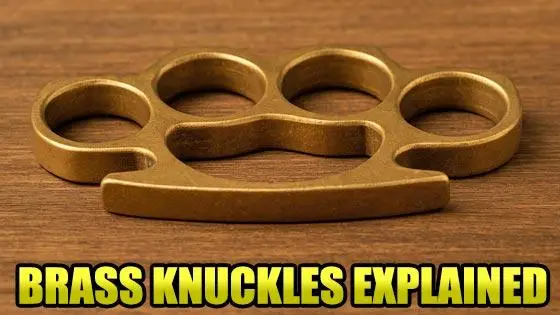Brass Knuckles Explained: History, Design, and Modern Laws
October 17th, 2025

Few weapons have a reputation as bold and instantly recognizable as brass knuckles. Also known as metal knuckles or knuckledusters, these compact hand-held tools have existed in one form or another for centuries. Their simple design, a set of finger rings joined by a solid grip, turns the user's hand into a reinforced striking surface. Although they are often associated with street fights and old-world brawls, brass knuckles have a much deeper history rooted in craftsmanship, military use, and self-defense innovation. Today, they are more often seen as collectible or display pieces rather than practical weapons, but their rugged appeal continues to make them a topic of fascination among martial artists and history enthusiasts alike.
What Are Brass Knuckles?
Brass knuckles, sometimes called metal knuckles or knuckledusters, are solid pieces of metal designed to fit around the fingers. When held in a closed fist, they reinforce the hand, allowing the user to deliver a harder impact while protecting the knuckles from injury. Most are made from brass, aluminum, or stainless steel, although modern versions can also be found in polymer or composite materials.
A typical set of brass knuckles includes four finger holes and a curved grip that rests in the palm. The outer surface is often smooth or rounded, but some designs feature decorative patterns, spikes, or engraved logos. These variations make brass knuckles appealing to collectors and enthusiasts who appreciate both their craftsmanship and their place in weapon history.
While originally intended as practical self-defense tools, brass knuckles are now mostly sold as novelty or display items. Their compact design and metallic finish make them stand out as striking conversation pieces and reminders of a bygone era of personal defense.
A Brief History of Brass Knuckles
The concept behind brass knuckles is far older than the metal versions we recognize today. Early forms of reinforced hand weapons date back to ancient Greece and Rome, where fighters wrapped leather or metal bands around their hands to protect their knuckles in combat. Similar ideas appeared across different cultures, each finding a way to strengthen the hand without restricting movement.
By the 19th century, the design had evolved into the familiar four-ring grip now known as the knuckleduster. Soldiers carried them in wars such as the American Civil War and World War I, where they were sometimes attached to trench knives to create hybrid close-quarters weapons. These metal knuckles gave soldiers an advantage in confined combat situations where firearms were impractical.
In the early 20th century, brass knuckles gained notoriety in street fights and organized crime, cementing their image as both dangerous and iconic. Despite that reputation, many versions were made with care and artistry, featuring engraved surfaces and ornate finishes. Today, that same blend of utility and craftsmanship makes them sought-after collectibles and decorative pieces rather than battlefield or street weapons.
How Brass Knuckles Are Made
Brass knuckles and other metal knuckles are made using a few different methods depending on the material, the finish, and whether the piece is intended as a functional tool or a decorative item. The basic process starts with a design, then moves into material selection, shaping, finishing, and quality checks.
Materials. Traditional pieces are cast from brass, which gives them a warm golden look and a satisfying weight. Aluminum and stainless steel are common alternatives, offering different balances of weight, durability, and cost. Modern novelty versions may use polymer or composite materials to mimic the look of metal while keeping weight and price down.
Production methods. For cast metal knuckles, manufacturers often create a mold from a master pattern. Molten metal is poured into the mold, allowed to cool, and then the rough casting is removed and cleaned. CNC machining is another option, especially for aluminum or stainless designs. Machined pieces start from a solid block of metal and are cut to shape with precise tooling, which produces clean edges and consistent dimensions.
Finishing. After shaping, the pieces are deburred and polished to remove sharp edges and tooling marks. Some makers intentionally age or patina brass to give it a vintage look. Others apply plating or anodizing to add color and corrosion resistance. Decorative touches such as engraving, inlays, or custom etching are added at this stage for collector or display pieces.
Assembly and inspection. If a design includes multiple parts, such as an inset grip or decorative plate, those elements are assembled and securely fixed in place. Each piece is then inspected for fit, finish, and structural soundness. High quality items show tight tolerances, smooth finger holes, and a finished grip that sits comfortably in the palm when handled for display.
Safety and display versions. Many contemporary sellers produce display or novelty variants that are thicker, blunt, or made from softer materials to avoid encouraging use. These are made with display safety in mind and often have rounded edges and dull faces. If an item is marketed for collectors, makers usually emphasize construction quality and finish rather than functionality.
In short, metal knuckles are as much a product of manufacturing choices as they are of design. Material, method, and finish determine whether a piece reads as a vintage collectible, a modern decorative item, or a budget novelty.
Are Brass Knuckles Legal?
The legality of brass knuckles varies widely from place to place. Some areas classify them as prohibited weapons, while others allow ownership but restrict carrying them in public. A few regions treat metal knuckles or knuckledusters the same way they do batons or other impact tools, meaning they may be legal to buy or display but not to use for self-defense.
When people ask "are knuckle dusters illegal," the honest answer is that it depends entirely on the laws where you live. Regulations can differ between states, provinces, and even cities, and those rules change over time. That is why it is always safest to research local statutes or consult a knowledgeable authority before purchasing or carrying any type of brass knuckles.
Many martial artists and collectors simply enjoy these items as display pieces or conversation starters. Owning brass knuckles as a collectible or decorative object is often viewed differently from carrying them for self-defense, but every jurisdiction defines those distinctions in its own way. Treating them as historical or artistic items rather than functional weapons is the most responsible approach for enthusiasts.
Brass Knuckles in Modern Culture
Brass knuckles have long been more than just a weapon. They have become a cultural symbol recognized around the world for their bold shape and tough image. From early gangster films to video games and tattoo designs, the knuckleduster has evolved into an icon of rebellion and rugged style. While its original purpose was purely practical, its distinctive look has made it a recurring design in fashion, art, and entertainment.
In movies, brass knuckles often represent grit, toughness, or underground fighting, even when they are used purely as props. The same image appears in artwork, belt buckles, and keychains, proving that the design itself carries a certain raw appeal. Collectors and martial arts fans appreciate this crossover between history and culture, where an old self-defense tool becomes a piece of visual storytelling.
At the same time, modern versions of brass knuckles are made mostly for display or novelty use. Many are designed with rounded edges or decorative finishes to highlight craftsmanship rather than function. This shift keeps the image alive while placing it firmly in the realm of artistry and cultural reference rather than combat.
Conclusion
From ancient hand guards to modern collectibles, brass knuckles have traveled a long path through history. Their simple design has remained largely unchanged for centuries, yet they continue to capture attention because of their craftsmanship and unmistakable shape. Whether referred to as metal knuckles or knuckledusters, these items reflect both innovation and artistry in self-defense design.
Today, most brass knuckles are appreciated as display pieces or conversation starters rather than practical weapons. They serve as reminders of an earlier time when form and function came together in the simplest possible way. If you want to explore authentic examples or modern variations, check out our full selection of brass knuckles available now on KarateMart.com.
You May Also Be Interested In:
- Are Brass Knuckles Legal? What to Know Before You Buy
- Brass Knuckles - Are They Too Dangerous To Have?!
- The History of the Kendo Uniform: From Samurai Armor to Modern Training
- The History of the Karambit: From Indonesian Farm Tool to Modern Tactical Icon
- Karate Belt Colors Explained: The Complete Belt Order from White to Black
- New Weapons for 2023: Knives, Swords and Knuckles!
- Hidden Blade Knuckles and Other Dangerous Weapons!
- A Brief History of Kung Fu
- A Brief History of Judo
- From Jungle Tool to Movie Legend: The History of the Machete
Leave a Reply
























